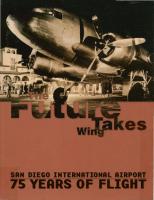Historic Ranchos of San Diego [First ed.]
115 pp., index, illustrations many in color, photographs, maps, mapped end boards. A fascinating book, much informatio
302 96 42MB
English Pages 120 [136] Year 1969
HISTORIC RANCHOS OF SAN DIEGO MAP
Copyright
Dedication
Contents
Introduction
1 Los Penasquitos Rancho
2 Jamul Rancho
3 Otay Rancho and Janal Rancho
4 Rancho San José del Valle and Rancho Valle de San José
5 San Dieguito Rancho
6 Jamacha Rancho
7 Los Vallecitos de San Marcos Rancho
8 Rancho Santa Margarita y las Flores
9 San Bernardo Rancho
10 Agua Hedionda Rancho
11 Las Encinitas Rancho
12 El Rincón del Diablo Rancho
13 Santa Maria Rancho
14 Santa Ysabel Rancho
15 Pauma Rancho and Cuca Rancho
16 Cañada de San Vicente Rancho
17 Guajome Rancho
18 Buena Vista Rancho
19 Cuyamaca Rancho
20 El Cajón Rancho and Rancho de la Cañada de los Caches
21 Rancho Guejito y Cañada de Palomia
22 Rancho de la Nación
23 Peninsula de San Diego Rancho
24 Monserrate Rancho
25 San Felipe Rancho
26 Rancho de la Misión San Diego de Alcala
Language of the Ranchos
Brand Meanings Are Lost
The Ranchos - What Their Names Mean in English
Cities and Towns - What Their Names Mean in English
In Appreciation
Reference Works
Artwork Sources
Colophon
Index
HISTORIC RANCHOS OF SAN DIEGO MAP
Recommend Papers
![Historic Ranchos of San Diego [First ed.]](https://ebin.pub/img/200x200/historic-ranchos-of-san-diego-firstnbsped.jpg)
- Author / Uploaded
- Cecil C. Moyer &
- Richard F. Pourade
- Similar Topics
- History
- American Studies
- Commentary
- Deskewed, OCR (Clearscan) , Bookmarked,
File loading please wait...
Citation preview
• ,,
""
-
1'��
··-:--.._,; . ,.
_1.., '.\
,,I•
.-..
·RIS.T0RIC RANCHOS . F '
I
,, �; j
•
f'
'
:
••
•.,
. '.
., .
' ...�-�...""""�
,
.. -,.• ... ,-� .. ·� , ...
.
\
""
' , ...
...,_ ..... ..
I
•
.
..
'� .
(
�.-.
'-4
r-'•
.. -'•�:
' �.
..
'. '4-,
..
r
;
.
G -·
.
iE
�-----:;,-------------i� I
Q
�
r1
�
lE Jt:·
AP
HISTORIC RANCHOS OF SAN DIEGO
Historic Ranchos of San Diego
COVER ILLUSTRATION
A gay wedding party, with the bride on her wedding saddle, winds up the hill from the Santa Margarita Rancho, singing or playing musical instruments.
Copyright 1969 by the Union-Tribune Publishing Co., San Diego, California. All rights reserved. No part of this book may be reproduced in any form without permission from the publishers. First edition printed in the United States of America. Library of Congress Catalog Card number 72-86951.
[liKSTORKC RANCKliOS OF SAN JDKEGO ' ' ' ·,: •·, �·
.
,_: ,: ' ' . .
.
_>.·
._:, :' ,
A COPLEY BOOK
Com1nissioned by JAMES S.
CoPLE Y
Text by C E c 1 L C . M o Y ER Edited by
RICHARD
F.
PouRADE
PUBLISHED BY UNION- TRIBUNE PUBLISHING CO .
Dedication In these modern times of rapid communication and transportation it is pleasing to reflect upon the pas toral scene of California in the early 19th century when neighbors only visited occasionally and often traveled more than a day to see each other. Each rancho was a community within itself, far removed from central government and under the autocratic control of the ranchero to whom the vast tract of land had been granted. Residents or visitors to San Diego County who to day enjoy the comforts of the new era, in mind's fancy, may look back through the pages of this book to the serenity and romance of the days of the ran chos and learn which of the historic land grants they can a sociate with current situations or residence. It is hoped Historic Ranchos of San Diego will bring pleasant reflections from a picturesque and ro mantic era never again to be seen in our world. }AMES S. COPLEY
15. Cuca Rancho 16. Canada de San V icente Rancho 17. Guajome Rancho 18. Buena V ista Rancho 1 g.
Cuyamaca Rancho
20.
El Cajon Rancho
20.
Rancho de la Canada de los Coches
21.
Rancho Guejito y Canada de Palomia
22.
Rancho de la Nacion
23. Peninsula de San Diego Rancho
Contents Introduction 1. Los Penasquitos Rancho 2.
Jamul Rancho
3. Janal Rancho
24. Monserrate Rancho 25. San Felipe Rancho 26. Rancho de la Misi6n San Diego de Alcala Brand Meanings The Ranchos-What Their Names Mean in English
3. Otay Rancho
Cities and Towns-What Their Names Mean in English
4. Rancho San Jose del Valle
In Appreciation
4. Rancho Valle de San Jose
Index
5. San Dieguito Rancho 6. Jamacha Rancho 7. Los Vallecitos de San Marcos Rancho 8. Rancho Santa Margarita y las Flores g. San Bernardo Rancho 10.
Agua Hedionda Rancho
11. Las Encinitas Rancho 12.
El Rincon del Diablo Rancho
13. Santa Maria Rancho 14. Santa Ysabel Rancho 15. Pauma Rancho
Foreigners merged with Californios in Days of the Dons. In English hunting coat. Edward Stokes at lVarner's Pass agrees to carry plea for troops to San Diego for Gen.- Stephen H'r1tt� Kearn y during Mexican H'rzr.
I
I
.,
;
i
I
r Ir r
)r7
.,., �. I , � .,
-'!''" -. -
I
•I
/' ' '/
/
Introduction The literature of the great rancho period of Califor nia is steeped in romanticism. The period is defined generally as the time between the breakup of the Franciscan mission system and the Americanization of California that came with the end of the United States-Mexican War. In San Diego, the rancho period began later than in some other areas of the state, all of its ranchos having been granted during the time California was a province of Mexico. But the period lasted longer in that change came slower and ranching remained a way of life well into the late 1800 's. The rancho period, so romantically known as the Days of the Dons, actually had two phases. Together they covered less than thirty years. But it was a feudal-like era in which each man was king and gov ernmental restraints were nonexistent, or limited. Even under Spanish rule, California was a remote territory subject to little direct influence of the King or the Church. The revolution in Mexico brought independence to a new nation, and to California a further lessening of the always fragile ties of domi nation from Mexico City. California was open to intrusions from all direc tions. W hen the Mexican revolutionists decreed the secularization of the missions, vast tracts of land in California were made available to soldiers and set tlers, as well as to American traders and adventurers who had felt, or hoped, that someday California would fall into their hands. Lands were passed out lavishly to the faithful. Tre-
mendous herds of cattle provided hides for shoe man ufacturers in New England and for tallow to be made into soap for South America. Within fifteen years, however, the more foresighted Dons saw that it could not last forever, that as the motherland of Mexico held little control over their affairs and their lands, and could provide little or no military protec tion, California might soon have to become a country of its own or become a possession of England, or of some other foreign nation. The government in Washington knew that too. The war between the United States and Mexico per haps merely hastened the inevitable. The resistance of the Californios was limited. California became a part of the United States. In the unsettled times that followed, the hapless Dons awoke to the fact that, despite pledges, the titles to the lands they had obtained through what they believed had been legal means, or by thinly dis guised seizures, had to be justified before a United States Land Commission, and often again in the courts. Hard times followed. Soon afterward the discovery of gold brought new life to the ranchos of the south. Great herds of cattle were driven north to Sacramento and San Francisco. For a time the silver on saddles grew heavier and lands Jarger. But that period, too, passed and the Days of the Dons were numbered. Few of them were able to hold onto their ranchos. The pressures of law suits and heavy migrations of land-hungry Ameri cans brought about a new era of agriculture and towns more than of ranching. Though ownerships changed, many of the more remote ranchos persisted through the years, shrink ing or increasing in size from time to time. Today on many of the original rancho lands cattle still roam the hills and valleys as they did a hundred years ago. But the life of the ranchos, or the Days of the Dons, lived in memory. This is the story of how the ranchos came about, and what happened to them, and if it too breathes with nostalgia, you can say that California does that to all of us, no matter when we came to its golden shore. R1cHARD
F.
PouRADE Vll
E
"'·
With c rud e maps ofte n e nlivened with color, the Do n s press ed th eir cl aims to ra nchos granted by M exico. Jose Joaqui n Ort ega's disef10 out lin ed Rancho Santa !1,1a ria which in time bec am e sit e of town of Ramo na .
--
) ii
a
dt
,, el,, ,r7 / !_/r.U.. .r
(f/1/rt'irec_
.J
2
�




![Frommer's San Diego [20th ed]
9781118337646, 9781118453001, 9781118453018, 9781118490518, 1118337646](https://ebin.pub/img/200x200/frommers-san-diego-20th-ed-9781118337646-9781118453001-9781118453018-9781118490518-1118337646.jpg)


![Field Guide to Amphibians and Reptiles of the San Diego Region [Reprint 2020 ed.]
9780520939035](https://ebin.pub/img/200x200/field-guide-to-amphibians-and-reptiles-of-the-san-diego-region-reprint-2020nbsped-9780520939035.jpg)
![Sea Cliffs, Beaches, and Coastal Valleys of San Diego County [Reprint 2020 ed.]
9780520322028](https://ebin.pub/img/200x200/sea-cliffs-beaches-and-coastal-valleys-of-san-diego-county-reprint-2020nbsped-9780520322028.jpg)
![Frommer's San Diego Day by Day (Frommer's Day by Day) [1 ed.]
0470209356, 9780470209356, 9780470287262](https://ebin.pub/img/200x200/frommers-san-diego-day-by-day-frommers-day-by-day-1nbsped-0470209356-9780470209356-9780470287262.jpg)